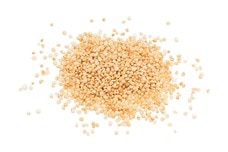Kaniwa vs. Quinoa: What’s the Difference?
The American Heart Association (2015) recommends that Americans eat at least half of their daily grains from whole grain sources. Whole grains are less processed, meaning that they contain more dietary fiber and other beneficial nutrients for health. This call from the American Heart Association has caused many people to seek new sources for whole grains in their diet. One of the most interesting new finds is called kaniwa. Yes, you read that right -- kaniwa, not to be confused with the similarly named quinoa. Distinguishing between kaniwa and quinoa can help you incorporate both of these healthy grains into your everyday diet.
Differences Between Kaniwa and Quinoa
Origins
Kaniwa and quinoa actually share very similar origins. Quinoa has been grown for thousands of years in the Andes Mountains of South America. Indigenous people of Peru, Bolivia, Ecuador, and Colombia prized this grain for its nutritional properties. Only a decade or two ago did it gain cache as a health food in the United States and around the world.
Like quinoa, kaniwa also hails from a South America. Cultivated in Peru and Bolivia, kaniwa is the seed from a flowering plant called goosefoot (Chenopodium pallidicaule). Quinoa is from the same genus (Chenopodium) but is a different species (quinoa) with slightly different properties.
Taste and Texture
Quinoa consists of small seed grains that may be red, dark brown, or white in appearance. Kaniwa are smaller than quinoa seeds -- about half the size -- and are dark red or brownish in color. Both quinoa and kaniwa have a delicious nutty flavor, although kaniwa is slightly sweeter than quinoa. Additionally, kaniwa has a slightly crunchy texture, while quinoa is fluffy and soft. These differences in texture and flavor may cause you to use the two grains differently while cooking.
Nutritional Benefits
Both quinoa and kaniwa are technically seeds, not grains, but they share many of the nutritional properties of whole grains. The seeds are naturally gluten-free, making them an ideal source of complex carbohydrates for people with celiac disease or gluten sensitivity. Both types of grain are excellent sources of fiber (Johnson, 2013). Additionally, they both are protein powerhouses. Quinoa and kaniwa are complete proteins, meaning that they contain all of the essential amino acids your body cannot produce itself (Roussell, 2012). Kaniwa is particularly high in lysine, an amino acid that is typically found only in small amounts in grain products.
Quinoa and kaniwa also contain a variety of vitamins and minerals that support your body’s physiological processes. These nutrients include iron, B vitamins, vitamin E, magnesium, phosphorus, zinc, copper, and manganese.
Cooking Times
Both quinoa and kaniwa cook relatively quickly. Toasting the seeds before cooking brings out a nutty flavor in the final cooked product. The most effective way to cook these seeds is to heat up water or broth to a boil, add the grain, and to cover the pan before reducing the heat to a bare simmer. After 20 to 25 minutes, the grain will have puffed up and absorbed all of the moisture. Fluffing the cooked grains with a fork prevents them from sticking to the pan.
The main difference when cooking quinoa and kaniwa is that kaniwa does not need to be rinsed before cooking. Quinoa seeds have an outer layer of saponins, a type of molecule that lends a slightly soapy flavor to the cooked quinoa if not properly removed. This is why it is important to rinse quinoa, as it washes away the saponins (Salkeld, 2013). Kaniwa contains no saponins and does not need to be rinsed before cooking. This may speed up your prep time slightly, but there are no other major differences when cooking the two grains.
Culinary Uses
Kaniwa and quinoa are relatively similar and can be enjoyed in many similar ways. However, there are subtle differences in texture and taste that set these grains apart. For example, the fluffy and soft texture of quinoa makes it ideal for blending into a smoothie for a healthy hit of protein and fiber. As quinoa is slightly larger than kaniwa, it is best for using as a stuffing for squash or peppers.
In contrast, the small size and slightly crunchy texture of kaniwa goes well in a pilaf with sliced bell peppers, olives, and feta cheese. Kaniwa also makes a great breakfast food. It is small enough to mix into pancakes without affecting their texture. Alternatively, it can be served with a bit of honey as a sweetener and topped with chopped nuts or diced fruit.
Additionally, kaniwa may be milled to create a flour. This protein-rich flour can be swapped for all-purpose flour in a variety of baked goods for a healthier kick. Just be careful when swapping flours, as protein-rich kaniwa flour may change the texture of the resulting product. Substitute no more than half of the flour called for in the recipe with kaniwa flour to achieve the best results.
Kaniwa and Quinoa Recipes
The following recipes include quinoa and, though many may be improved by simple substitution, others are ideal for the seed the recipe suggests. Find meals to make with either grain with the simple guide below.

Chocolate Goji Berry Bars Recipe {gluten-free}
This crunchy energy bar relies on the puffed form of quinoa to provide its airy texture. While kaniwa is naturally crunchy, its small size does not easily lend itself to the base of this tasty treat.
Ingredients: Pitted dates, almond butter, quinoa puffs, goji berries, raw pistachios, coconut oil, dark chocolate chips.
Total Time: 20 minutes
| Yield: 8 bars

Kale Quinoa Salad Recipe
This salad relies on a pseudocereal for a source of protein and a light texture interspersed through its refreshing body. Kaniwa could add a slight crunch, posing the possibility of an improved plate with this seed substitution.
Ingredients: Quinoa, fresh baby kale, purple cabbage, carrots, fresh dill, boiled eggs, rice wine, extra virgin olive oil, black pepper.
Total Time: 25 minutes
| Yield: 8 servings
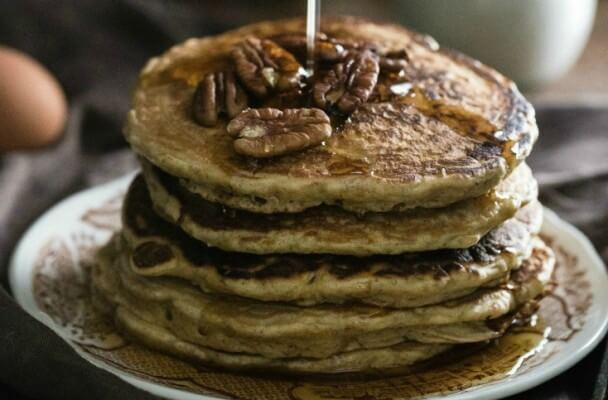
Quinoa Pancakes Recipe
While this recipe makes an explicit call to use quinoa, as stated above, the small size of kaniwa would better suit the expected texture of a flapjack. Try this recipe with the smaller of the two seeds today!
Ingredients: Quinoa, whole wheat pastry flour (or brown rice flour for gluten-free cakes), eggs, milk, maple syrup or honey, raw pecans, baking powder, vanilla extract, salt.
Total Time: 15 minutes
| Yield: 7 pancakes

Quinoa Tabbouleh Salad Recipe {gluten-free}
Tabbouleh is a dish traditionally made with bulgur, a cereal most often made from wheat. As a result, the soft consistency of quinoa makes a perfect replacement- while the smaller, crisper kaniwa may fall short.
Ingredients: Quinoa, cherry tomatoes, red onion, cucumber, extra virgin olive oil, balsamic vinegar, fresh parsley, fresh mint, black pepper, salt.
Total Time: 40 minutes
| Yield: 4 servings
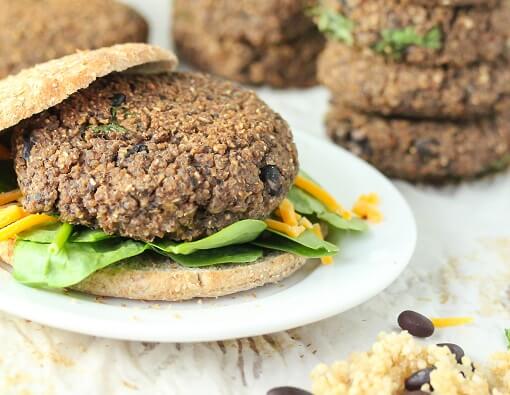
Quinoa Fritters Recipe
Unless you fancy a crunchy burger, these fritters are better served with quinoa as its complement to the beans and oats that compose its tender texture. That being said, with quinoa, these fritters are a superb substitute to traditional meat patties.
Ingredients: Quinoa, black beans, gluten-free rolled oats, egg, cumin powder, salt, cilantro.
Total Time: 25 minutes
| Yield: 12 medium-sized fritters
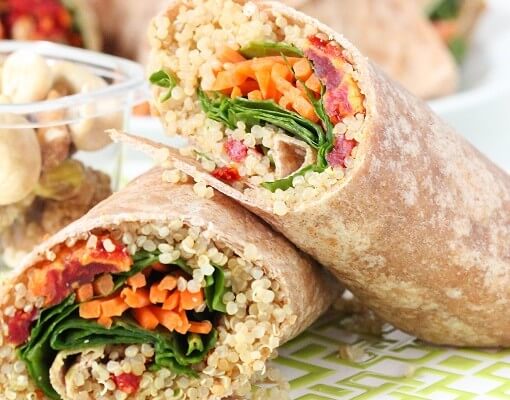
Quinoa Veggie Wrap Recipe {vegan}
This simple wrap supplies a soft crunch from spinach that could become more pronounced with a kaniwa substitution. While any grain should allow for a cohesive bond between the fillings, we recommend opting for either grain.
Ingredients: Tortilla wraps, quinoa, hummus, fresh spinach, sun-tomatoes, shredded carrots.
Total Time: 30 minutes
| Yield: 4 wraps
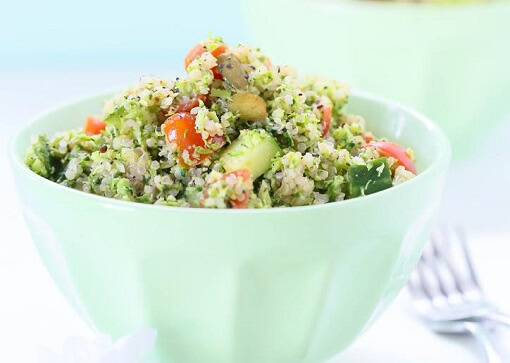
Broccoli Quinoa Salad Recipe {gluten-free}
The broccoli bits blended to bring an even consistency to this salad may seem small when tossed with quinoa. Try using kaniwa for an even crunch throughout the dish that is just as good, if not better than the original.
Ingredients: Fresh broccoli, quinoa, cucumber, cherry tomatoes, raw pumpkin seeds, sea salt, black pepper, Dijon mustard (optional), vinegar, extra virgin olive oil, maple syrup.
Total Time: 1 hour
| Yield: 8 servings
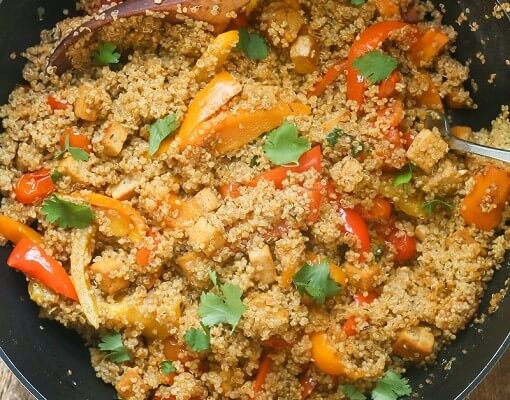
Veggie Quinoa Casserole Recipe {gluten-free, vegan}
As stated above, a casserole may provide the perfect medium for enjoying kaniwa. Try the smaller of the seeds for a twist on this palatable plate, or enjoy the recipe as written with a scrumptious serving of quinoa.
Ingredients: Quinoa, extra firm tofu, bell peppers, cherry tomatoes, olive oil, paprika, cumin, oregano, thyme, salt.
Total Time: 35 minutes
| Yield: 4 - 5 servings
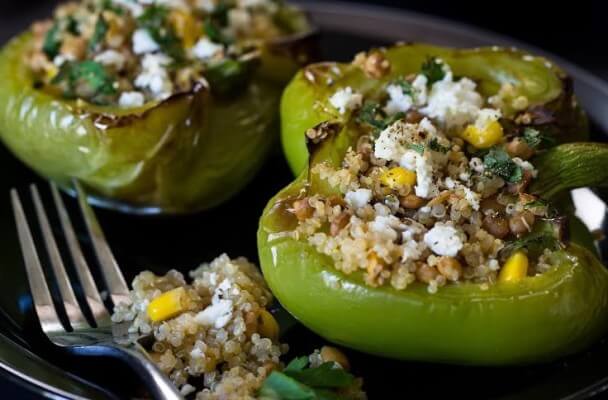
Quinoa Stuffed Peppers Recipe {gluten-free}
As stated above, stuffed peppers is a perfect place to use quinoa and would likely lend a lesser medium for kaniwa. Stick to quinoa in this recipe for a healthy dinner dish or hors d'oeuvre that’s simply delish!
Ingredients: Quinoa, green bell peppers, canned lentils, fresh spinach, feta cheese, frozen corn (thawed), salt, black pepper.
Total Time: 40 minutes
| Yield: 6 servings (8 half-peppers)
Kaniwa and Quinoa Products
While we only carry the organic kaniwa below, we carry a vast assortment of quinoa products ranging from quinoa flour to spicy quinoa pilaf. You can find a sample of our superfood cereal seeds below.
Healthy Eating
- Healthy Snacks
- Healthy Meals
- Healthy Recipes
- Sports Nutrition
- Nutrition and Special Diets
- 21 Day Fix
- 5 Popular Diet Similarities
- Alkaline Diet
- Anti-Inflammatory Diet
- Calorie Counting
- Carb Cycling Diet
- Celiac Disease
- Cholesterol
- Clean Eating
- Crohn's Disease
- DASH Diet
- Detox Diet
- Diabetes
- Diabetes Diet
- Diet Pill Dangers
- Fat Burning Foods
- Gluten-free Diet
- Glycemic Index
- Heart Health
- High Blood Pressure Diet
- High Fiber Foods
- How to Eat Healthy
- How to Lower Blood Pressure
- Hypertension
- IBS Diet
- Ketogenic Diet
- Liquid Diet
- Low GI Foods
- Low-Carb Diet and Foods
- Low-Fat High-Carb Diet
- Mediterranean Diet
- Mediterranean Diet Foods
- Military Diet
- Nutrition Labels Explained
- Paleo Diet
- Raw Food Diet
- Superfoods
- Sustainable Weight Loss
- Thrive Diet
- Vegan Diet
- Vegetarian Diet
- Weight Loss Shakes
- Whole30
- Vitamins, Minerals & Nutrients

